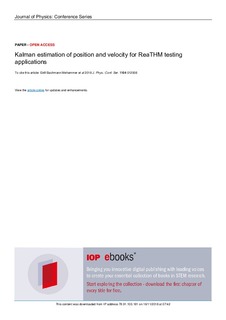Kalman estimation of position and velocity for ReaTHM testing applications
Mehammer, Eirill Bachmann; Føre, Martin; Sauder, Thomas Michel; Chabaud, Valentin Bruno; Parisini, Thomas
Journal article, Peer reviewed
Published version
Permanent lenke
http://hdl.handle.net/11250/2574912Utgivelsesdato
2018Metadata
Vis full innførselSamlinger
- Publikasjoner fra CRIStin - SINTEF Ocean [1387]
- SINTEF Ocean [1461]
Sammendrag
Offshore wind power research is a rapidly growing field, because of the present climate crisis and increasing focus on renewable energy. Model testing plays an important role in the risk and cost analysis associated with offshore wind turbines (OWTs). The real-time hybrid model testing concept (ReaTHM testing) solves important challenges related to model testing of OWTs, such as achieving an accurate modelling of the wind field, and the occurrence of scaling issues when modelling wind and waves simultaneously. However, ReaTHM test set-ups are generally sensitive to noise, signal loss and inaccuracies in sensor values. The present study is focused on the design and implementation of a state estimator able to accurately estimate the position and velocity of floating structures, while taking disturbances into account. By combining the information received from several different sensors with mathematical models, the estimator provides smooth and reliable position and velocity estimates for ReaTHM testing applications. The main objective of the present study is to develop a kinematic state space model that could represent the motion of any floating structure in six degrees of freedom (6-DOF). The kinematic model is implemented in MATLAB, and acceleration time series obtained with numerical simulations are used as inputs. The computed outputs agree with the corresponding simulated motions. A Kalman estimator based on the state space model is designed, implemented and tested against virtual data from the numerical model, with artificially added disturbances. Sensitivity analyses addressing the robustness towards noise, time delays, signal loss and uncertainties are performed to identify the limits of the estimator. The estimator is demonstrated to be robust to most types of disturbances. Further, the state estimator is tested against physical data from laboratory experiments. Good agreement between the physically measured and the estimated states is observed. Kalman estimation of position and velocity for ReaTHM testing applications

